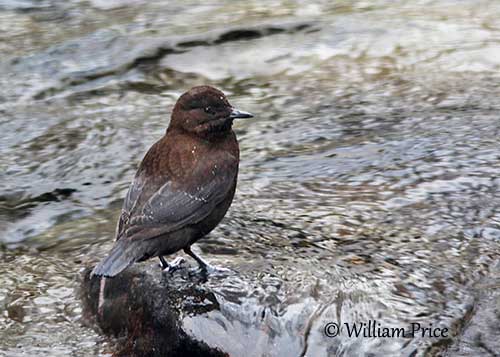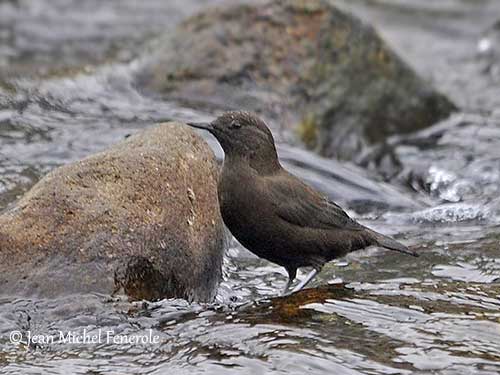
PROTECTION / THREATS / STATUS:
The Brown Dipper is usually common and widespread along suitable streams and rivers throughout the large range.
The species is threatened in Himalayan foothills by irrigation and deforestation, and the population is declining in Nepal. It is hunted for food in China and SE Asia.
The global population is suspected to be stable, and the species is not currently threatened and evaluated as Least Concern.
Fr: Cincle de Pallas
Ang: Brown Dipper
All: Pallaswasseramsel
Esp: Mirlo-acuático Pardo
Ita: Merlo acquaiolo bruno
Nd: Zwarte Waterspreeuw
Sd: brun strömstare
Photographers:
John Anderson
John Anderson Photo Galleries
Jean Michel Fenerole
Photos d’Oiseaux du monde
William Price
PBase-tereksandpiper & Flickr William Price
Text by Nicole Bouglouan
Sources:
HANDBOOK OF THE BIRDS OF THE WORLD Vol 10 by Josep del Hoyo-Andrew Elliott-David Christie - Lynx Edicions - ISBN: 8487334725
WRENS, DIPPERS AND THRASHERS by Brewer David – illustrated by Barry Kent Mackay- Yale University Press - ISBN: 0300090595
Birds.kz - Kazakhstan Birdwatching Community
Wiley Online Library - Flood avoidance behaviour in Brown Dippers Cinclus pallasii
Glen Chilton – Ornithologist. Author. Adventurer - A Tough Time For Dippers
Family Cinclidae
Page Passeriformes Order
Summary cards
Brown Dipper
Cinclus pallasii
Passeriformes Order – Cinclidae Family
INTRODUCTION:
The Brown Dipper is a robust, streamlined species with semi-aquatic lifestyle. It is found in E and S Asia, and three subspecies share this wide range. They only differ by depth of brown plumage coloration.
The short, broad wings with powerful muscles allow the bird to propel itself into the water, even in difficult conditions. The long, strong legs and feet with sharp curved claws are used to grip rocks and mosses along the water.
It frequents fast-flowing streams and rivers, from 900 to 3,500 metres of elevation. It feeds on aquatic invertebrates and occasionally small fish.
The Brown Dipper is not globally threatened and the population is currently stable.
DESCRIPTION OF THE BIRD:
Biometrics:
Length: 21-23 cm
Weight: M: 87 g – F: 76-86 g
The Brown Dipper of nominate race has dark chocolate-brown plumage overall, including the head, with more rufous-tinged back and breast. Wings and tail are darker. The underwing is mostly dark grey-brown.
The blackish bill is slender and slightly hooked. The eyes are brown with white-feathered eyelids. Legs and feet are blackish-brown.
Male and female are similar, although the female is slightly smaller than male.

The juvenile is duller with blackish-brown plumage. Head and throat are spotted greyish-white, whereas back, breast and belly show greyish-white scalloping. On the wing, secondaries and tertials are edged greyish-white, like the rectrices.
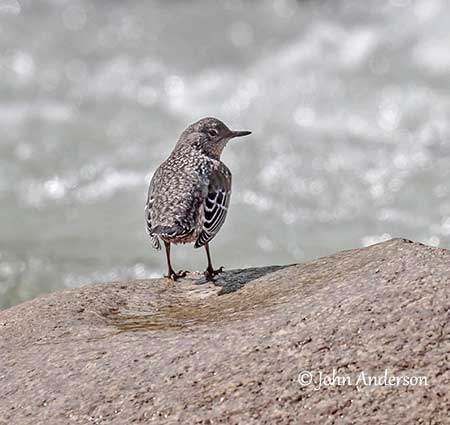
Juvenile
Race C.p. tenuirostris
SUBSPECIES AND RANGE:
The Brown Dipper has three subspecies.
C.p. pallasii (described above and displayed) is found in E Russia, C and E China, Korea, Sakhalin, S Kuril Islands, Japan and Taiwan.
C.p. tenuirostris (displayed) occurs in Tian Shan, S to N Afghanistan, and from NW Pakistan, E in Himalayas to Sikkim.
This race is paler than nominate.
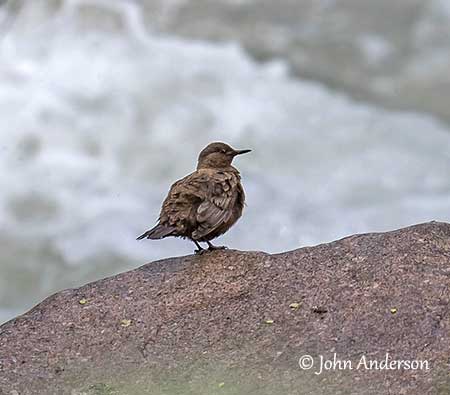
C.p. dorjei (not displayed) is found in E Himalayas E to mountains of W, N and E Myanmar, S China, N and C Laos and NW Vietnam.
This race is darker and smaller than previous. The juvenile is more rufous than in other races, with less conspicuous pale edges on wings and tail.
HABITAT:
The Brown Dipper frequents rapid mountain rivers with rocky shores, and mainly larger rivers in the forest belt between 1,500 and 3,200 metres of elevation. It can be found locally from foothills to above 5,000 metres.
It needs clear and unpolluted water with stony beds that provide abundant invertebrate prey items.
CALLS AND SONGS: SOUNDS BY XENO-CANTO
The Brown Dipper gives sharp calls “zit zit” or “dzchit dzchit” similar to White-throated Dipper.
The song is a loud, rich warble including buzzing notes, trills and rattles, possibly given by both adults. It is often delivered from a rock low in the water or from other perches or the bank.
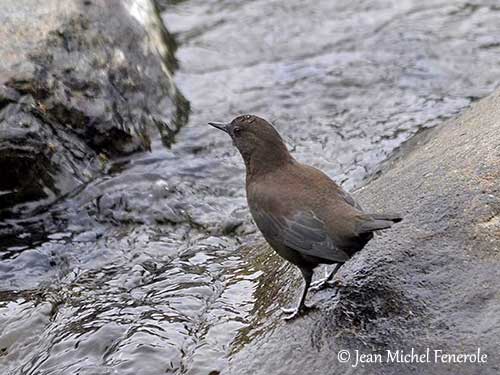
BEHAVIOUR IN THE WILD:
The Brown Dipper feeds mainly on various aquatic invertebrates including mayflies, larvae of caddis flies, nymphs of stoneflies and others. Small fish can be taken occasionally.
It forages by diving into streams where it can find benthic organisms, but it also wades in shallower waters where it picks small invertebrates of the bottom. The bird often blinks while diving, showing the white eyelid enhanced by the contrast with the dark plumage.
The Brown Dipper is vulnerable to floods that reduce food availability, and their survival could be threatened by extreme flooding, especially during the breeding season.
The Brown Dipper is monogamous and solitary nester. They are territorial throughout the year, but mainly during the breeding season. The breeding territory is usually close to productive rivers, and this species maintains linear territories along these rivers.
Advertising displays with male perched upright while moving wings and head, and display flights by both mates with chases accompanied by songs are observed during this period.
The Brown Dipper is resident, but it may perform some altitudinal movements. It descends to 1,000/1,300 metres in October/November, and reaches the nesting areas in April/May. However, numerous birds remain at high elevation all year-round.
The flight is fast and direct and usually low over the water, often following a watercourse.
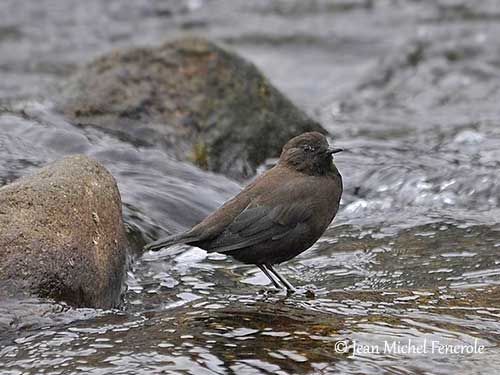
REPRODUCTION OF THIS SPECIES:
The breeding season takes place from December to July/August according to the elevation. This species usually produces two broods per season.
Both adults build the nest above flowing water, in rock crevice, cliff ledge, behind waterfall, about 30 centimetres to 2 metres above water. They also nest under bridges, in caves or rocks among falling water. The same nest is often reused in several following years.
Both adults needs 7-10 days to build the nest, a large globular structure of moss, with grass (or not), and a side entrance. It is lined inside with softer materials. The outer diameter may reach 22-28 centimetres, and the entrance hole is 8 centimetres across.
The female lays 3-6 (usually 4-5) white eggs. The incubation lasts 19-20 days, probably by the female alone. The chicks are fed by both parents. They fledge about three weeks after hatching, usually between 21 and 24 days. They hide among rocks, vegetation and tree roots on the bank, where they are still fed by the adults. They are able to dive and swim to escape a danger.
The nests are occasionally parasitized by cuckoos of genus Cuculus, subfamily Cuculinae.
